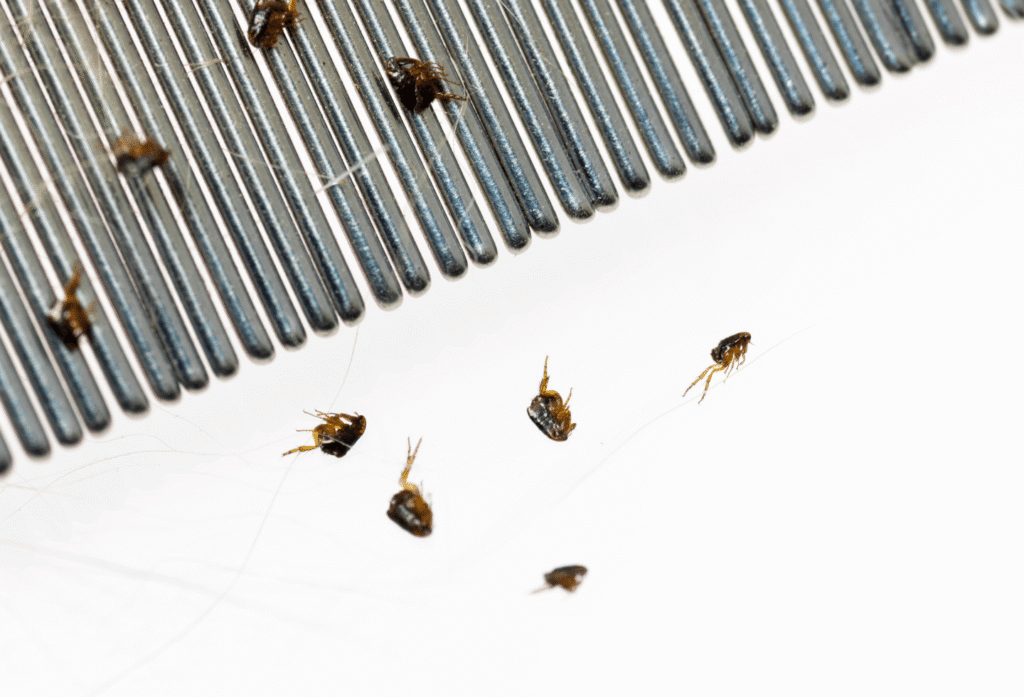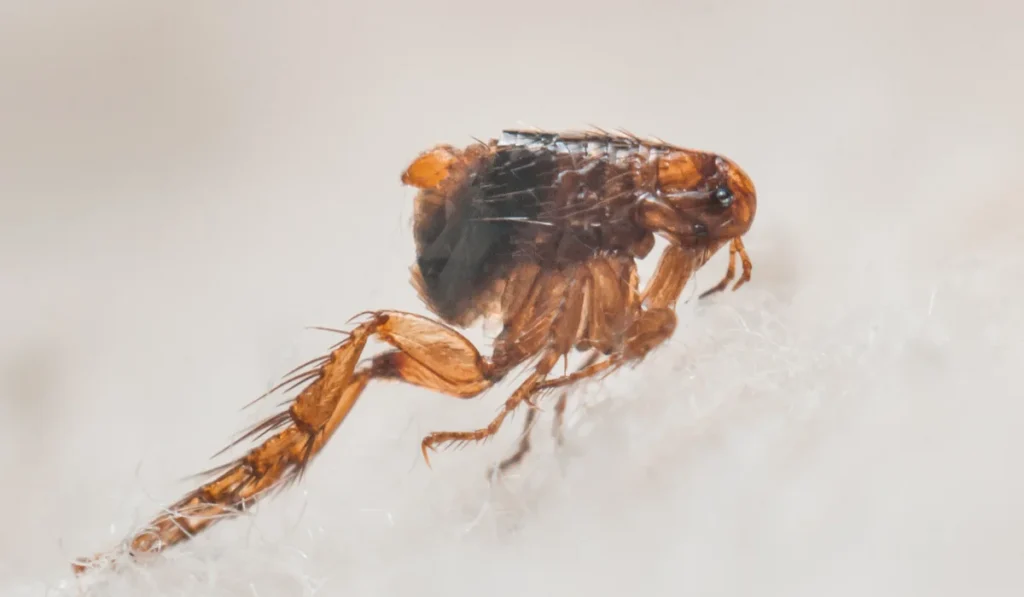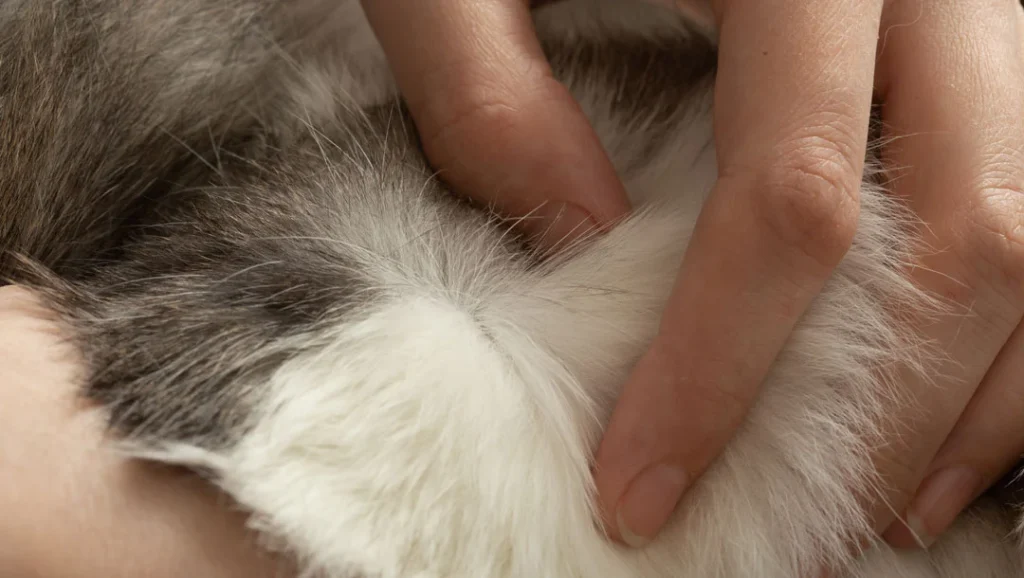Fleas often create invisible problems that grow worse before anyone realizes what is happening. You may notice your pet scratching more than usual, or perhaps you wake up with small, itchy red bumps. Then the question appears: are fleas actually visible to the naked eye, or are they just too small and elusive to see? Understanding how, when, and where you can identify fleas without magnification helps you take control early. Spotting fleas is not always easy, but once you know what to look for, it becomes much more manageable.
This guide is written for people who are already dealing with suspicious signs, and want direct, human-centered answers—not just data. You will learn what fleas look like, where they hide, and how their behavior influences visibility. Whether you’re a pet owner, a tenant in an infested space, or simply someone trying to understand what’s jumping in your carpet, this is for you.
Understanding Flea Visibility
Yes, you can see adult fleas with your naked eye. They are small, but not microscopic. Their size ranges from 1.5 to 3.3 millimeters, and they have a distinct dark brown or reddish color. If you’ve ever seen a small speck suddenly jump from your pet’s fur, that was likely a flea.
Fleas are visible in specific conditions. Natural light, contrast between fur and skin, or movement often reveal them. But their speed and ability to hide deep within fur or fabrics make them challenging to catch. Eggs and larvae, on the other hand, are far more difficult to detect without a closer, more focused inspection.
Recognizing fleas early is not just about eyesight. It’s about knowing where to look and what behaviors or secondary signs indicate their presence.
What Fleas Look Like to the Human Eye
To the human eye, fleas look like tiny, dark, fast-moving insects. They do not resemble dust or scabs. Their bodies are narrow and laterally compressed, which helps them slide through fur with ease.
Fleas do not fly. They jump. This is often the first sign of their presence: a quick, unexpected hop across a pillow, your sock, or your pet’s back. If you’ve seen a small insect dart and vanish in the blink of an eye, chances are it was a flea.
Their dark coloration makes them hard to see on dark-haired pets or furniture, but extremely easy to spot on white or light-colored surfaces. This contrast becomes a critical factor in visibility.
How Movement Helps You Spot Them
Fleas rarely stay still. They are hyper-responsive to touch, heat, and light. This movement is what allows most people to detect them.
When you disturb a flea’s resting place—by brushing your pet, adjusting bedding, or vacuuming—it triggers a jump response. This movement is not random. It’s sharp, fast, and directional.
If you see something jump when you walk across a carpet or run your hand through fur, pay attention. A single jump can reveal a much larger infestation that hasn’t yet become fully visible.
How Big Are Fleas Really?

Average Flea Size in Millimeters
Adult fleas typically range from 1.5 millimeters to 3.3 millimeters. That’s slightly larger than a pinhead. The most common species found on pets, the cat flea (Ctenocephalides felis), falls squarely within this range.
This size is within the resolution of the human eye, but because fleas are flat and dark, they often appear smaller than they are—especially when stationary.
Their body is hard and durable. If you manage to catch one between your fingers, it’s surprisingly difficult to crush. This durability also adds to their ability to go unnoticed while moving through fur.
Flea Size Compared to Common Objects (Salt, Sand, Hair)
Visual comparisons help make this more relatable:
- Fleas are about the size of a grain of salt, but much darker.
- Compared to sand, fleas are slightly longer but more mobile.
- A human hair is around 0.07 mm in diameter. A flea is around 20 to 40 times that size.
When you understand their scale, it becomes easier to differentiate a flea from other tiny particles on your pet or furniture. What makes them unmistakable is not just size, but movement and shape.
Where to Look for Fleas on Pets

Common Hiding Spots on Dogs and Cats
Fleas prefer warm, moist, and protected areas. On dogs and cats, they gravitate toward specific zones where fur density is high and scratching is difficult.
Common areas include:
- Base of the tail
- Neck and collar region
- Groin and inner thighs
- Behind the ears
Fleas cluster in these areas because the skin is thin, the blood flow is high, and the animal’s tongue or claws cannot easily reach. During an infestation, checking these regions first can save time and confirm presence faster.
How to Check Fur and Skin Properly

Use your fingers to part the fur slowly. Look close to the skin, not on the fur surface. Fleas stay near the base of the fur shaft, not on top.
A flea comb with fine teeth is useful. Drag the comb through your pet’s fur, then tap it on a white paper towel. Look for moving insects or dark specks.
Lighting is important. Use natural daylight or a strong lamp. Also pay attention to your pet’s behavior. If they scratch a certain spot repeatedly, start there.
Signs of Fleas You Can See Without Magnification
Flea Dirt (Black Specks on Fur)
One of the most visible and consistent signs of a flea problem is flea dirt. These are tiny black particles, often mistaken for pepper or soil.
Flea dirt is actually dried blood. When placed on a wet paper towel, it dissolves into a reddish-brown color. This is one of the easiest ways to confirm flea presence.
Check areas near the tail, stomach, and underarms. If you find black specks that stain red, fleas are almost certainly present—even if you do not see them moving yet.
Flea Eggs and Larvae (Harder to Spot)
Flea eggs are tiny, white, and oval-shaped. They resemble dandruff but are much smaller. Because they are smooth and non-sticky, they fall off the host easily and end up in bedding, carpets, or furniture.
Larvae look like thin, white worms. They avoid light and burrow into dark, quiet areas. You won’t likely see them unless you’re inspecting carpet fibers or corners very closely.
While not impossible to see, eggs and larvae require intentional searching. You need a flashlight and good eyesight or a magnifying glass to spot them reliably.
Small Red Bite Marks on Skin
Flea bites on humans usually appear in clusters or lines. They are small, red, and intensely itchy. The most common areas are ankles, waist, and lower legs.
On pets, flea bites can be harder to see due to fur. However, secondary signs like red, irritated skin, scabs, or consistent scratching indicate their presence.
You may not always see the flea, but you will feel the effects. If bites appear overnight and you don’t have bed bugs, suspect fleas—especially if you have pets.
Why Fleas Are Hard to See Sometimes
Flea Color and Camouflage
Fleas are dark-colored, which allows them to blend into fur, carpets, or fabric. On black dogs or dark bedding, they are almost invisible until they move.
Their slim profile also helps. They can slip between fur strands or hide in fabric seams without disrupting the surface. It is easy to miss them even when they are right in front of you.
When visibility is poor, rely on contrast. Use white bedding or place your pet on a white towel during checks. This helps reveal fleas more clearly.
Fast Movement and Hiding Behavior
Fleas move quickly and decisively. Unlike lice, which crawl slowly, fleas either dart or jump. When disturbed, they flee instantly, making it difficult to get a good look.
They hide in carpet fibers, upholstery seams, and under furniture. Even if you see one jump, finding it again can be impossible unless you’re prepared.
Fleas are active when the environment is quiet. This means infestations often go unnoticed until they escalate. You might only see them when vacuuming or turning over cushions.
Light and Contrast Conditions
You are more likely to spot fleas during daylight. Natural sunlight or directional light from a lamp highlights their shape and movement.
Low light conditions, such as evening or dim rooms, reduce visibility dramatically. That is when fleas are most active, but also hardest to detect.
Creating contrast helps. Place white sheets on dark carpets or vice versa. Use a flashlight at ground level to catch reflections off flea bodies.
Tools That Can Help You See Fleas More Clearly
Flea Comb Test
A flea comb is an essential tool for any pet owner. It’s not just about finding fleas but also monitoring progress during treatment.
Use the comb especially around the tail, neck, and underbelly. Check the comb after each pass. If you see small insects or black debris, you likely have fleas.
Repeat the process after bathing your pet or applying treatment. Flea combs help confirm whether the solution is working.
White Sock Test
The white sock test works best in homes with carpeted floors. Wear clean white socks that reach mid-calf and walk slowly through suspected areas.
Fleas jump onto the socks in search of a host. If you spot dark specks after walking through pet zones, fleas are active in your environment.
This method is particularly useful before and after home treatment to assess effectiveness.
Using a Flashlight or Magnifying Glass
A flashlight angled low across the carpet can expose movement and reflections from fleas. Sweep slowly and look for sudden motion.
A magnifying glass enhances small specks and helps you confirm whether they are insects or lint. It is useful for examining bedding seams or flea comb findings.
Combined, these tools allow you to detect even low-level infestations.
Can You See Fleas in Your Home?
Fleas on Furniture, Carpets, and Bedding
Yes, you can see fleas in your home—if you know where to look. Check seams of cushions, corners of rugs, and pet bedding.
They prefer dark, warm, and undisturbed areas. During the day, they stay hidden in carpet fibers or under furniture. At night, they emerge and jump when they sense heat or movement.
Pets usually deposit flea eggs and dirt in their sleeping areas. Start there during any inspection.
Spotting Flea Dirt or Tiny Jumping Insects
Even if you do not see adult fleas, flea dirt provides visual proof. Use white fabrics to highlight specks. Tap your pet’s fur or bedding and examine what falls out.
Adult fleas are sometimes seen as tiny, fast-moving or jumping insects when a room is disturbed. Do not mistake them for gnats or lint—they move differently and tend to disappear quickly.
Persistent signs like itching, dirt, and fast-moving dots mean it’s time to act.
When to Seek Professional Help
If You See Fleas but Can’t Find Their Source
If you keep seeing fleas but cannot find where they are nesting, they might be in floor cracks, wall voids, or deep upholstery.
In such cases, vacuuming and sprays might not be enough. Pest control professionals use treatments that target all flea stages—including eggs and larvae.
Act quickly. The longer fleas remain, the harder they are to remove. Early professional help saves time and prevents re-infestation.
If You Have Bites but No Visible Fleas
Bites without sightings often indicate a hidden infestation. Fleas may be emerging from baseboards, vents, or nearby pets. Even if you do not own pets, fleas can enter from neighbors or previous tenants.
If symptoms continue and you cannot confirm visually, call a licensed pest expert. They have tools like flea traps and light-based detection to locate the source.
Ignoring the problem leads to worsening bites and spreading eggs. If you’re unsure, it’s better to act early.
Conclusion: Fleas Are Small but Definitely Visible If You Know Where to Look
You can absolutely see fleas with the naked eye, but knowing how to spot them makes all the difference. Their small size, dark color, and fast movement can be tricky, but they leave behind signs—like flea dirt and bite marks—that confirm their presence. With proper lighting, inspection tools, and attention to behavior, you can detect fleas before an infestation worsens. Combine visual checks with awareness of where they hide and how they move, and you gain full control over the problem before it controls your space.
